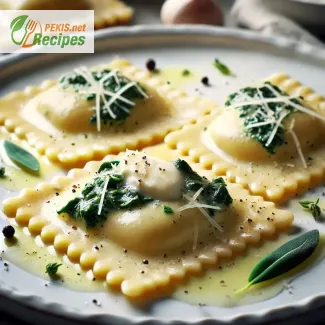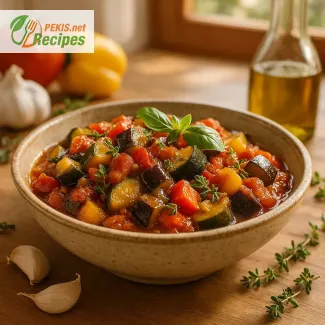
Stuffed Ravioli with Ricotta and Spinach is an exquisite, timeless dish that captures the essence of Italian comfort food while offering a delightful blend of textures and flavors. Every bite brings a harmonious fusion of creamy ricotta and fresh spinach, delicately wrapped in tender pasta that holds the filling to perfection. This dish, while deeply rooted in Italian tradition, has grown to embody both sophistication and versatility, making it a popular choice across cultures and dining styles. With a filling that highlights both simplicity and richness, each raviolo offers a symphony of flavors that unfolds beautifully with each bite.
At the heart of these stuffed ravioli is the creamy ricotta cheese, known for its smooth, almost fluffy consistency. Ricotta’s mild, slightly sweet flavor is a perfect partner for spinach, creating a filling that is both luscious and light. When seasoned with a touch of nutmeg, salt, and freshly ground pepper, the filling takes on a subtly complex character, adding depth without overpowering the delicate taste of the pasta shell. The nutmeg adds a gentle warmth, enhancing the ricotta’s creaminess and creating an inviting aroma that wafts from the dish as it cooks.
The spinach in this ravioli is carefully selected and prepared to maintain its bright, fresh flavor and vibrant green color. Lightly sautéed, the spinach softens without losing its delightful crispness, balancing the smoothness of the ricotta with its slight earthy undertones. Rich in iron, vitamins, and antioxidants, spinach also adds a nutritional boost, making each bite as nourishing as it is delicious. This blend of ricotta and spinach represents a marriage of textures, where each element complements the other for a truly balanced filling.
The pasta itself is traditionally made from semolina or fine wheat flour and eggs, rolled to a delicate thinness to showcase the filling within. The dough is kneaded to the ideal consistency, allowing it to be tender yet sturdy enough to hold the generous filling without breaking apart during cooking. When cooked, the ravioli achieves a perfect al dente texture, slightly firm to the bite yet tender, with a satisfying elasticity that highlights the effort put into creating each individual piece.
Once prepared, the stuffed ravioli can be dressed in a variety of sauces, each adding its own unique flair. A classic butter and sage sauce accentuates the richness of the ricotta while providing an aromatic contrast that is both rustic and elegant. As the butter melts and browns, it releases a nutty aroma that complements the sage’s earthy tones, creating a silky coating that clings to each raviolo without overwhelming its delicate flavors. A light drizzle of extra virgin olive oil is also an excellent option, allowing the taste of the pasta and filling to shine through with a subtle peppery finish.
For those who prefer a slightly more robust flavor profile, a marinara or tomato-based sauce can be an excellent choice, providing a bright acidity that cuts through the creaminess of the ricotta while enhancing the natural sweetness of the spinach. Fresh basil, garlic, and a hint of red pepper flakes can elevate the dish, adding layers of flavor that create a harmonious balance with each bite. Alternatively, a creamy Alfredo or béchamel sauce creates a luxuriously smooth texture, making this dish indulgent and perfect for special occasions.
One of the most remarkable qualities of stuffed ravioli with ricotta and spinach is its versatility. It can be served as a light starter or a hearty main course, adapting easily to any dining occasion. Whether prepared for a family gathering or a romantic dinner, this dish has the unique ability to evoke feelings of warmth, care, and celebration. Garnished with a sprinkle of freshly grated Parmesan cheese and a crack of black pepper, it achieves a delightful balance of flavor and presentation, inviting everyone to savor its wholesome goodness.
The visual appeal of these ravioli is equally captivating, as each piece is carefully crafted to hold its filling, often sealed with a fork’s edge or gently twisted to create an inviting pattern along the pasta’s edge. This attention to detail not only ensures that the filling stays secure during cooking but also adds an artisanal touch that showcases the care and tradition involved in its preparation.
Stuffed ravioli with ricotta and spinach embodies the artistry of Italian cuisine, where simple ingredients are transformed into something extraordinary. The flavors are gentle yet refined, showcasing the natural qualities of each ingredient without excessive seasoning or complexity. This is a dish that celebrates the joy of cooking and the pleasure of sharing a meal made with care. Whether paired with a glass of white wine, such as a crisp Pinot Grigio or a light Chardonnay, or enjoyed with a simple sparkling water, the experience of eating stuffed ravioli with ricotta and spinach is a timeless reminder of the beauty of Italian culinary tradition.
In sum, this dish is more than just a meal; it is a tribute to the joy of authentic Italian flavors and the craftsmanship behind each bite. Perfectly balanced and endlessly satisfying, stuffed ravioli with ricotta and spinach will always hold a place at the table as a cherished classic, capturing the hearts of those who savor its elegant simplicity and unparalleled taste.
1. Prepare the pasta dough:
- On a clean surface, place the flour in a mound and create a well in the center.
- Crack the eggs into the well. Using a fork, beat the eggs gently, gradually incorporating the flour from the edges.
- Continue mixing until a dough forms, then knead by hand for about 10 minutes until smooth and elastic. If the dough feels too sticky, add a small amount of flour.
- Wrap the dough in plastic wrap and let it rest for 30 minutes.
2. Prepare the filling:
- In a pan over medium heat, sauté the garlic until fragrant, about 1 minute.
- Add the spinach and cook until wilted, about 3-4 minutes. Remove from heat and let cool.
- Once the spinach has cooled, mix it with ricotta, Parmesan, salt, pepper, and a pinch of nutmeg in a medium bowl. Stir until well combined.
3. Roll out the pasta:
- Divide the dough into two equal parts. Using a pasta machine or rolling pin, roll each piece of dough into a thin sheet (about 1 mm thick).
- Place small spoonfuls of filling about 5 cm apart on one sheet of dough.
- Brush the areas around the filling with a small amount of water to help seal the pasta.
- Lay the second sheet of dough over the first, pressing gently around each mound of filling to remove air pockets and seal.
- Using a ravioli cutter or knife, cut around each mound to form individual ravioli. Set them aside on a floured tray.
4. Cook the ravioli:
- Bring a large pot of salted water to a gentle boil.
- Carefully add the ravioli to the boiling water and cook for 4-5 minutes, or until they float to the surface.
5. Prepare the sauce:
- While the ravioli cooks, melt the butter in a pan over medium heat. Add the sage leaves if using and cook until the butter turns golden brown and fragrant (about 2 minutes).
- Once the ravioli are cooked, drain them and add them to the pan with the butter sauce. Toss gently to coat.
6. Serve:
- Plate the ravioli and sprinkle with freshly grated Parmesan cheese. Serve immediately for the best flavor and texture.
When it comes to preparing Stuffed Ravioli with Ricotta and Spinach, there are numerous ways to enhance the dish, adjust its nutritional profile, and accommodate various dietary preferences. Below are several practical tips and suggestions to influence the recipe positively, making it not only more delicious but also healthier and more versatile.
1. Enhance the Dough
Use Whole Wheat Flour: One of the simplest modifications you can make is to use whole wheat flour instead of all-purpose flour for the pasta. Whole wheat flour contains more fiber, which aids digestion and helps maintain stable blood sugar levels. The nuttier flavor of whole wheat can also add depth to the taste of the ravioli.
Experiment with Other Flours: For a gluten-free option, consider using a blend of gluten-free flours such as almond flour, rice flour, or chickpea flour. These alternatives can provide unique flavors and textures while catering to those with gluten sensitivities.
2. Modify the Filling
Incorporate Additional Vegetables: To boost the nutritional value of the filling, consider adding other vegetables. Mushrooms can enhance the umami flavor while providing additional nutrients such as vitamin D and selenium. Zucchini can add moisture and a subtle sweetness, while kale or Swiss chard can provide a nutrient-dense alternative to spinach.
Add Herbs and Spices: Fresh herbs such as basil, parsley, or thyme can elevate the flavor profile of the filling significantly. Herbs are also rich in antioxidants, which can contribute to overall health. A pinch of nutmeg or red pepper flakes can also add a hint of warmth and depth to the flavor.
Utilize Alternative Cheeses: If you're looking to reduce fat content, you could substitute part-skim ricotta for regular ricotta. Alternatively, cottage cheese can be used for a lower-calorie option while still maintaining a creamy texture. For a dairy-free option, consider using nut-based cheeses or tofu blended with nutritional yeast to mimic the creaminess of ricotta.
3. Sauce Alternatives
Lighten the Sauce: Traditional butter and sage sauce can be quite rich. To make it lighter, use extra virgin olive oil instead of butter. This will reduce saturated fat and increase healthy monounsaturated fats. Add fresh herbs and a splash of lemon juice to brighten the flavors.
Use Tomato-Based Sauces: For a lighter and tangier alternative, serve the ravioli with a fresh tomato sauce made from ripe tomatoes, garlic, and basil. Tomatoes are rich in lycopene, an antioxidant linked to many health benefits.
Creamy Sauces: If you prefer a creamier sauce, consider using a light béchamel made with low-fat milk or a yogurt-based sauce. This will keep the dish rich and satisfying without the extra calories of heavy cream.
4. Serving Suggestions
Pair with Fresh Salads: Serve the ravioli with a side of fresh, lightly dressed greens, such as arugula or spinach salad with a citrus vinaigrette. This not only adds a refreshing contrast to the richness of the ravioli but also boosts the meal’s fiber and nutrient content.
Garnishes: Enhance the presentation and flavor by garnishing with toasted pine nuts or chopped walnuts for added crunch and healthy fats. A sprinkle of freshly grated Parmesan cheese or a drizzle of balsamic glaze can also elevate the dish.
5. Prepare in Advance
Freezing for Convenience: Stuffed ravioli can be made ahead of time and frozen before cooking. This is particularly useful for meal prep and can save time on busy nights. To freeze, lay the ravioli on a baking sheet lined with parchment paper until firm, then transfer to a freezer bag.
Make Large Batches: Consider preparing a double batch of the ravioli and sharing them with family or friends. Homemade pasta makes for a wonderful gift or a fun cooking activity with loved ones.
6. Dietary Modifications
Accommodate Allergies: To make the dish suitable for those with dietary restrictions, replace the ricotta with a dairy-free alternative, and use gluten-free flour for the pasta. This way, you can cater to individuals with lactose intolerance or gluten sensitivity.
Reduce Sodium: To lower the sodium content, avoid adding extra salt to the pasta dough and filling, and be mindful of the salt content in cheeses. Fresh ingredients and herbs can add flavor without the need for additional salt.
By implementing these tips, you can create a more nutritious, flavorful, and accommodating version of Stuffed Ravioli with Ricotta and Spinach. Whether you're looking to enhance the dish's health benefits, cater to dietary restrictions, or simply elevate the flavors, these modifications will help you craft a delicious meal that appeals to a wide range of tastes and preferences. Cooking is about creativity and adaptability, and these suggestions provide the perfect opportunity to personalize this classic Italian dish while maintaining its core essence. Enjoy your culinary adventure!
Allergen Presence:
- Dairy: The ricotta and Parmesan cheese contain lactose, which may be problematic for those with lactose intolerance.
- Eggs: Eggs are used in the pasta, presenting an allergen for individuals allergic to eggs.
- Gluten: The flour used in the dough contains gluten, making it unsuitable for individuals with celiac disease or gluten sensitivity.
Ingredient Substitution Tips to Eliminate Allergens and Gluten:
- For Ricotta: Use silken tofu or a dairy-free ricotta made from nuts (like cashews) blended with nutritional yeast for a creamy texture.
- For Parmesan: Replace with nutritional yeast, which provides a similar cheesy flavor without dairy.
- For Eggs: Substitute with a flaxseed meal mixture (1 tablespoon of flaxseed meal mixed with 3 tablespoons of water) to act as a binder in the dough.
- For Flour: Use gluten-free flour blends (like almond flour or rice flour) to make the pasta without gluten.
- Calcium:
- Content: Approximately 300 mg per serving (from dairy ingredients).
- Importance: Essential for maintaining strong bones and teeth; also plays a vital role in muscle function and nerve transmission.
- Vitamin A:
- Content: Approximately 400 IU per serving (from ricotta and spinach).
- Importance: Important for maintaining healthy vision, immune function, and skin health.
- Vitamin K:
- Content: Approximately 180 mcg per serving (from spinach).
- Importance: Crucial for blood clotting and bone health, helping to reduce the risk of osteoporosis.
- Iron:
- Content: Approximately 3 mg per serving (from spinach).
- Importance: Vital for the production of hemoglobin, which carries oxygen in the blood and prevents fatigue and anemia.
- Vitamin C:
- Content: Approximately 15 mg per serving (from spinach).
- Importance: Acts as a powerful antioxidant, protecting cells from oxidative stress and supporting the immune system.
- Beta-Carotene:
- Content: Approximately 500 mcg per serving (from spinach).
- Importance: Converts to vitamin A in the body, providing antioxidant benefits and supporting eye health and skin integrity.
- Flavonoids:
- Content: Varies based on the freshness and type of spinach.
- Importance: Reduce inflammation and help protect against chronic diseases, including certain types of cancer.





